Paul du Toit: A Conversation with Ashraf Jamal
Featured in Art South Africa Volume 12 Issue 2
Ashraf Jamal: Hello Paul! I’m immensely interested in your populist appeal and professional success as an artist. Could you talk about why your work is enjoyed so much? Do you have any tips for young aspiring artists about how to capture the public eye and wallet?!
Paul du Toit: From the outset I wanted to create a very personal form of art for which there was no market in the beginning. If you are not making money from your art then it is a hobby and not a career. I was very influenced and exposed to Modern Art from a young age so I wanted to incorporate elements of it in my work. If you look at many collections that my works are in, you will notice that those collectors love modern art. For many of these collectors, when most of the Modern artists passed away, no new works were created. So they find my work is an extension in a way. The Modern artists came from Europe and were very influenced by art from Africa. I studied their work in return and I’m bringing it back to Africa with a strong influence from South Africa.
As for artists starting out I would say: just start! It is easier than ever to make it and get a following for your work using the Internet as a tool for exposure. You have to work all the time and if your work is unique then the collectors will find you. Art takes a long time to develop. A great starting point is the course run by the Business School opposite the Waterfront. The course is called Business Acumen for Artists.
As for artists starting out I would say: just start! It is easier than ever to make it and get a following for your work using the Internet as a tool for exposure. You have to work all the time and if your work is unique then the collectors will find you. Art takes a long time to develop. A great starting point is the course run by the Business School opposite the Waterfront. The course is called Business Acumen for Artists.
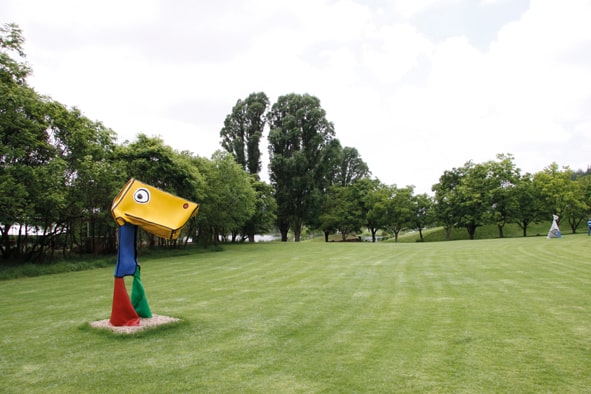
Paul du Toit, Expanded canvas series, 2012. Concrete, canvas and polyurathane paint.
AJ: I love the brilliance of colour and the lean lines of your work! My guess is that [Joan] Miro is a big inspiration. Could you talk about your method, style, and your love of colour?
PDT: I was very fortunate to grow up in an artist’s studio from a very young age. I was exposed to Miro and European Modern Art when I was hospitalized as a child with Rhumatoid Arthritis, and my artist aunt who travelled to Spain showed me books on Miro after seeing the crude drawings I was making during art therapy sessions. I had this moment where I went “Oh, wow it is OK to draw and paint like this.” Up until then I was drawing what I was seeing, so studying these works helped me to paint from my imagination and paint what I was thinking. It takes a lifetime to build a career and my method, style and love for colour was developed over a long painstaking journey. I always say that it feels like I started a painting some thirty years ago and now I just keep adding to it. It is a bit like handwriting, and if you are lucky as an artist you find your own style. This usually happens at 4am when you least expect it. I was very lucky to meet Chuck Close when we worked on a project together in NYC. He always says that inspiration is for amateurs, the rest of us just show up for work. It is only through work that you discover what you want to do.
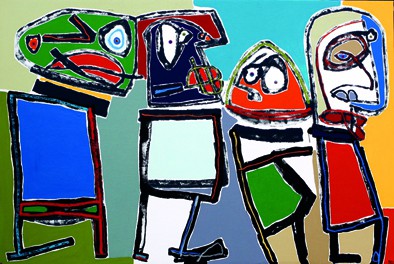
Paul du Toit, Cosmic attraction, 2011. Oil, oil paint sticks and acrylic on canvas.
AJ: South African art is generally rather miserable, desaturated, or monochromatic … it seems to me that you’ve fighting against our inherited gravitas, and trying to push for a kind of hi-art-lite; could you talk about this?
PDT: Especially the Architects in this country I find to be colour-blind. They seem to find a monochromatic colour each year and then suddenly every building is “Bovine” or some grey. I’ve got no idea why they are so against using colour. Colour makes you happy and we are such a colourful interesting nation.
AJ: Naive Art, Art Brut, Abstract Art, Pop Art; these seem to be some of the connectors that spring to mind when looking at your art. How did you come to make the aesthetic choices you’ve made?
PDT: Art Brut is where I fit in the best and where I am the most comfortable. I once did this study on which artist influenced the artists I followed. I looked at Keith Haring’s work and he was mostly influenced by Jean Dubuffet, which not a lot of people know. I traced the influences all back to the year 1275. All artists build on what has gone before. All art is an abstraction of something. In the end we are all influenced by some kind of mark making.
AJ: A local precursor, and perhaps and inspiration for your work, could be Norman Catherine. What do you think of his work? Do you find any connections?
PDT: Norman Catherine’s work is strongly influenced by a cartoon artist from Pittsburg or Philadelphia in The States where Norman spent some time, I can’t remember the artist’s name but I remember looking at their work in the 80’s. Norman has managed to rework the same characters over the years. For me the only similarities in our work might be the primary colours we use; if you really look at the work then there is no direct influence. I like his work.
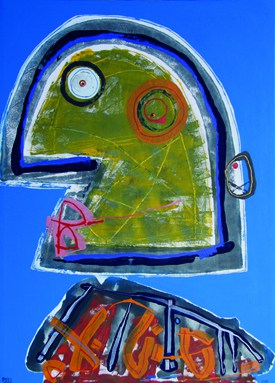
Paul du Toit, Odd, 2012. Oil, oil paint sticks and acrylic on canvas.
AJ: Lets talk a bit more about Miro – the art and the sculptures – can we develop the connections here?
PDT: My early sculptures are influenced by many artists, but Miro helped me get over them all very quickly. The more I studied his work the more I got influenced by his methods and ways of thinking. For instance, I now use my paintings and drawings as blueprints to create sculptures. This way you also learn how to solve problems in the planning stages. I learned how to use my own work and create more work from there.
AJ: Afropop is a buzz word I like because it’s easy, breezy, light. Does this descriptor gel with you? Or do you have a better, clearer, more interesting hanger? Is there anything about African art – sculpture, curio, design innovation – which has inspired you?
PDT: I’m always looking at colourful masks to see if there is something unique that inspires me, but I have yet to come across anything African that moves me. I like art with guts created from nothing. So often artists copy each other directly and overwork things. I like to think of my work more like AfroPunk. When people see something different and unique for the first time they always try and relate it to something else. Even when people meet someone for the first time they will say that the person reminds them of someone else.
AJ: Your art makes people very happy, an important feeling which we forget about. Could you talk about peoples/buyers responses to your work?
PDT: Luckily the people that buy my work are not sheep and they buy the works because they love it and get it. I cannot live with dark and heavy art around me, and love to be surrounded by happy creatures. At the same time I have managed to develop my own strange alphabet of marks that I adapt to form portraits and abstractions of hominids. That is why I created PlanetPaul with the idea to colonize this Planet with weird creatures and even do animations from time to time. It is interesting when collectors tell me their stories of what they see in the works.
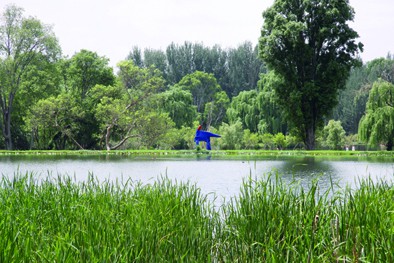
Paul du Toit, Expanded canvas series, 2012. Concrete, canvas and polyurathane paint.
AJ: Your work speaks very well to the design world … is it the breathiness of your work? The use of space and line? The fab colour?
PDT: There is a strong overlap with design at times and I have been very fortunate to meet some of the best designers of our time and even spend time in their studios in Milan and Hong Kong. The biggest challenge is to know when to stop. It is far more difficult to create something simplistic that works. Through experience you get to use space and line to get a balanced effect; the use of colour is instinctive I find.
AJ: Do you think of your work as African, or as a part of broader global art context? What of Keith Haring or [Jean-Michel] Basquiat?
PDT: From the beginning I was forced in a way to look globally, as my work was not excepted here from the start. Luckily I never studied art formally and studied programming computers for a short time. I feel uncorrupted by not having studied art formally. With the launch of the Internet in South Africa I was in an ideal position to create my own website and reach out globally. I used to think I was born in the wrong era and would have loved to be around when Modern Art was at a peak. Over time I have come to realize that I should have been in NYC in the mid eighties when all my favourite artists were still alive and creating very groundbreaking art; like Basquiat, another one of my influences. I discovered most of his work quite late but we had the same influences and I understand completely the space he was in when creating his immense body of work. My goal from the outset was to go global and I was very fortunate to have a studio in Brooklyn NYC. The best part of this art journey has been the traveling and people we have met and become friends with.
AJ: Pop is the defining global zeitgeist. It’s often thought of as frothy, silly, banal … what is your view of Pop Art? who are your favourites? do you see yourself as belonging to a tradition?
PDT: I live by the original Punk ethos where you get out there and do things for yourself. I often joke and say that I studied art at the Independent School for Self-education. Pick up a paintbrush and just start creating. I don’t like to belong to groups and for me Pop is related to fashion in some way. I like to think that my works will stand the test of time, and in a way that is happening – when I look at demand for older works at auction or in the secondary market. For me Pop also indicate mass production. I only create original pieces or very small editions where each piece is similar but unique. If you look at an original Warhol or Lichtenstein and feel and notice the textures, you can see the artistic talent. They did not trace works from a projector.
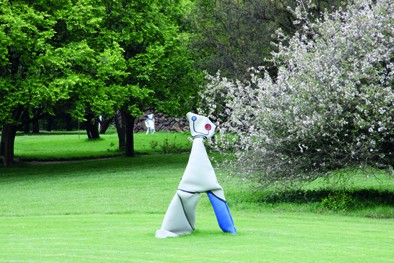
Paul du Toit, Expanded canvas series, 2012. Concrete, canvas and polyurathane paint.



